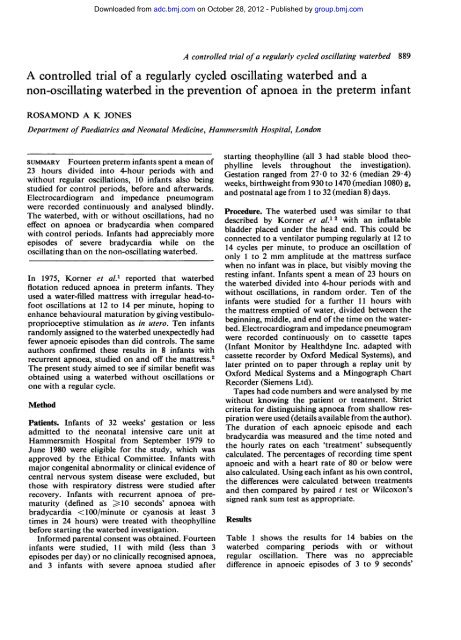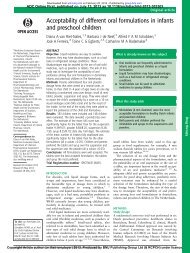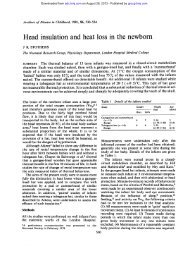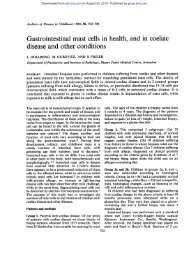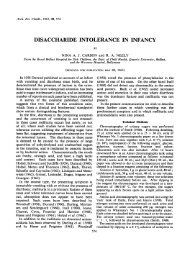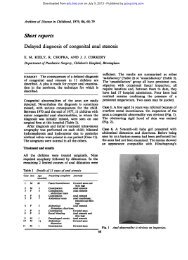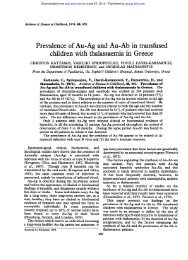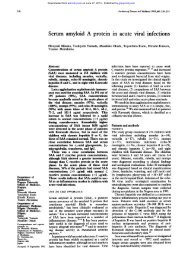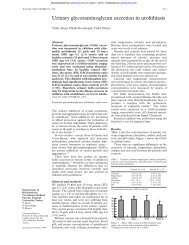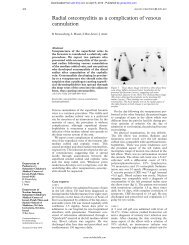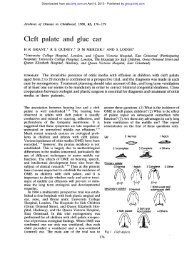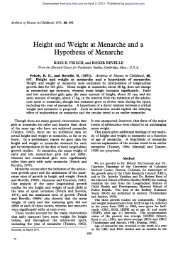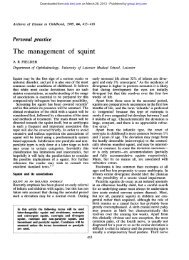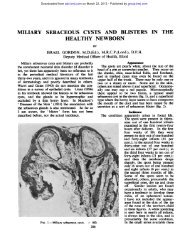non-oscillating waterbed in the prevention of apnoea in the preterm ...
non-oscillating waterbed in the prevention of apnoea in the preterm ...
non-oscillating waterbed in the prevention of apnoea in the preterm ...
You also want an ePaper? Increase the reach of your titles
YUMPU automatically turns print PDFs into web optimized ePapers that Google loves.
A controlled trial <strong>of</strong> a regularly cycled <strong>oscillat<strong>in</strong>g</strong> <strong>waterbed</strong> 889<br />
A controlled trial <strong>of</strong> a regularly cycled <strong>oscillat<strong>in</strong>g</strong> <strong>waterbed</strong> and a<br />
<strong>non</strong>-<strong>oscillat<strong>in</strong>g</strong> <strong>waterbed</strong> <strong>in</strong> <strong>the</strong> <strong>prevention</strong> <strong>of</strong> <strong>apnoea</strong> <strong>in</strong> <strong>the</strong> <strong>preterm</strong> <strong>in</strong>fant<br />
ROSAMOND A K JONES<br />
Department <strong>of</strong> Paediatrics and Neonatal Medic<strong>in</strong>e, Hamnmersmith Hospital, London<br />
SUMMARY Fourteen <strong>preterm</strong> <strong>in</strong>fants spent a mean <strong>of</strong><br />
23 hours divided <strong>in</strong>to 4-hour periods with and<br />
without regular oscillations, 10 <strong>in</strong>fants also be<strong>in</strong>g<br />
studied for control periods, before and afterwards.<br />
Electrocardiogram and impedance pneumogram<br />
were recorded cont<strong>in</strong>uously and analysed bl<strong>in</strong>dly.<br />
The <strong>waterbed</strong>, with or without oscillations, had no<br />
effect on <strong>apnoea</strong> or bradycardia when compared<br />
with control periods. Infants had appreciably more<br />
episodes <strong>of</strong> severe bradycardia while on <strong>the</strong><br />
<strong>oscillat<strong>in</strong>g</strong> than on <strong>the</strong> <strong>non</strong>-<strong>oscillat<strong>in</strong>g</strong> <strong>waterbed</strong>.<br />
In 1975, Korner et al.1 reported that <strong>waterbed</strong><br />
flotation reduced <strong>apnoea</strong> <strong>in</strong> <strong>preterm</strong> <strong>in</strong>fants. They<br />
used a water-filled mattress with irregular head-t<strong>of</strong>oot<br />
oscillations at 12 to 14 per m<strong>in</strong>ute, hop<strong>in</strong>g to<br />
enhance behavioural maturation by giv<strong>in</strong>g vestibuloproprioceptive<br />
stimulation as <strong>in</strong> utero. Ten <strong>in</strong>fants<br />
randomly assigned to <strong>the</strong> <strong>waterbed</strong> unexpectedly had<br />
fewer apnoeic episodes than did controls. The same<br />
authors confirmed <strong>the</strong>se results <strong>in</strong> 8 <strong>in</strong>fants with<br />
recurrent <strong>apnoea</strong>, studied on and <strong>of</strong>f <strong>the</strong> mattress.2<br />
The present study aimed to see if similar benefit was<br />
obta<strong>in</strong>ed us<strong>in</strong>g a <strong>waterbed</strong> without oscillations or<br />
one with a regular cycle.<br />
Method<br />
Downloaded from<br />
adc.bmj.com on October 28, 2012 - Published by group.bmj.com<br />
Patients. Infants <strong>of</strong> 32 weeks' gestation or less<br />
admitted to <strong>the</strong> neonatal <strong>in</strong>tensive care unit at<br />
Hammersmith Hospital from September 1979 to<br />
June 1980 were eligible for <strong>the</strong> study, which was<br />
approved by <strong>the</strong> Ethical Committee. Infants with<br />
major congenital abnormality or cl<strong>in</strong>ical evidence <strong>of</strong><br />
central nervous system disease were excluded, but<br />
those with respiratory distress were studied after<br />
recovery. Infants with recurrent <strong>apnoea</strong> <strong>of</strong> prematurity<br />
(def<strong>in</strong>ed as >10 seconds' <strong>apnoea</strong> with<br />
bradycardia
890 Jones<br />
Downloaded from<br />
adc.bmj.com on October 28, 2012 - Published by group.bmj.com<br />
duration nor was <strong>the</strong>re any difference <strong>in</strong> bradycardia<br />
<strong>of</strong> 80 or below. Only 6 <strong>in</strong>fants had apnoeic attacks <strong>of</strong><br />
10 seconds or more, and <strong>in</strong> 5 <strong>the</strong>se were more<br />
frequent on <strong>the</strong> <strong>oscillat<strong>in</strong>g</strong> bed. Eleven <strong>in</strong>fants<br />
suffered severe bradycardia <strong>of</strong> 60 or less per m<strong>in</strong>ute<br />
and <strong>the</strong>se episodes were significantly more frequent<br />
dur<strong>in</strong>g periods <strong>of</strong> regular oscillation.<br />
Table 2 shows results for <strong>the</strong> 10 <strong>in</strong>fants <strong>in</strong> whom a<br />
control period with <strong>the</strong> <strong>waterbed</strong> emptied was<br />
recorded. None <strong>of</strong> <strong>the</strong> parameters measured showed<br />
Table 1 Comparison <strong>of</strong> <strong>the</strong> <strong>waterbed</strong> with and without<br />
oscillations (n - 14)<br />
Oscillat<strong>in</strong>g P* (paired t test)<br />
bed m<strong>in</strong>us<br />
<strong>non</strong>-<strong>oscillat<strong>in</strong>g</strong> bed<br />
(mean ± SD)<br />
Apnoea<br />
3-9 seconds<br />
hourly rate +0-46 ± 1-14 >0.1<br />
*Apnoea<br />
210 seconds +0-13** >0-1**<br />
hourly rate (-0-01 to +0*31)<br />
% time apnoeic +0-08 + 0-16 0.050.1<br />
% time with<br />
heart rate<br />
0.1<br />
***Bradycardia<br />
6 60/m<strong>in</strong>,<br />
hourly rate +0*19 + 0*21
I thank Dr David Southall for use <strong>of</strong> equipment<br />
for analys<strong>in</strong>g <strong>the</strong> tapes, Pr<strong>of</strong>essor M Healy for<br />
help with statistics, Dr Pamela Davies for advice<br />
throughout <strong>the</strong> study, and <strong>the</strong> parents and <strong>in</strong>fants.<br />
This work was generously supported by Action<br />
Research for <strong>the</strong> Crippled Child. Water mattresses<br />
were donated by Flotronaire Limited and cassette<br />
tapes by Sony Limited.<br />
References<br />
Downloaded from<br />
adc.bmj.com on October 28, 2012 - Published by group.bmj.com<br />
Korner A F, Kraemer H C, Haffner M E, Cosper L M.<br />
Effects <strong>of</strong> <strong>waterbed</strong> flotation on premature <strong>in</strong>fants: a<br />
pilot study. Pediatrics 1975; 56: 361-7.<br />
2 Korner A F, Guillem<strong>in</strong>ault C, Van den Hoed J, Baldw<strong>in</strong><br />
R B. Reduction <strong>of</strong> sleep apnea and bradycardia <strong>in</strong><br />
<strong>preterm</strong> <strong>in</strong>fants on <strong>oscillat<strong>in</strong>g</strong> <strong>waterbed</strong>s: a controlled<br />
polygraphic study. Pediatrics 1978; 61: 528-33.<br />
British Paediatric Association<br />
A controlled trial <strong>of</strong> a regularly cycled <strong>oscillat<strong>in</strong>g</strong> <strong>waterbed</strong> 891<br />
3 Kuzemko J A, Paala J. Apnoeic attacks <strong>in</strong> <strong>the</strong> newborn<br />
treated with am<strong>in</strong>ophyll<strong>in</strong>e. Arch Dis Child 1973; 48:<br />
404-6.<br />
4 Kattw<strong>in</strong>kel J, Nearman H S, Fanar<strong>of</strong>f A A, Katona P G,<br />
Klaus M H. Apnea <strong>of</strong> prematurity: comparative<br />
<strong>the</strong>rapeutic effects <strong>of</strong> cutaneous stimulation and nasal<br />
cont<strong>in</strong>uous positive airway pressure. J Pediatr 1975; 86:<br />
588-92.<br />
Daily W J R, Klaus M, Meyer H B P. Apnea <strong>in</strong> premature<br />
<strong>in</strong>fants: monitor<strong>in</strong>g, <strong>in</strong>cidence, heart rate changes, and<br />
an effect <strong>of</strong> environmental temperature. Pediatrics 1969;<br />
43: 510-8.<br />
6 Kramer L I, Pierpo<strong>in</strong>t M E. Rock<strong>in</strong>g <strong>waterbed</strong>s and<br />
auditory stimuli to enhance growth <strong>of</strong> <strong>preterm</strong> <strong>in</strong>fants.<br />
JPediatr 1976; 88: 297-9.<br />
Correspondence to Dr R A K Jones, Jenny L<strong>in</strong>d Children's<br />
Department, Norfolk and Norwich Hospital, Brunswick<br />
Road, Norwich NRI 3SR.<br />
Received 30 June 1981<br />
Annual meet<strong>in</strong>gs<br />
1982 20-24 April Aviemore Centre, Scotland<br />
1983 12-16 April York University<br />
1984 10-14 April York University<br />
1985 16-20 April York University
Downloaded from<br />
adc.bmj.com on October 28, 2012 - Published by group.bmj.com<br />
Email alert<strong>in</strong>g<br />
service<br />
Notes<br />
A controlled trial <strong>of</strong> a regularly<br />
cycled <strong>oscillat<strong>in</strong>g</strong> <strong>waterbed</strong> and<br />
a <strong>non</strong>-<strong>oscillat<strong>in</strong>g</strong> <strong>waterbed</strong> <strong>in</strong><br />
<strong>the</strong> <strong>prevention</strong> <strong>of</strong> <strong>apnoea</strong> <strong>in</strong> <strong>the</strong><br />
<strong>preterm</strong> <strong>in</strong>fant.<br />
R A Jones<br />
Arch Dis Child 1981 56: 889-891<br />
doi: 10.1136/adc.56.11.889<br />
Updated <strong>in</strong>formation and services can be found at:<br />
http://adc.bmj.com/content/56/11/889<br />
These <strong>in</strong>clude:<br />
To request permissions go to:<br />
http://group.bmj.com/group/rights-licens<strong>in</strong>g/permissions<br />
To order repr<strong>in</strong>ts go to:<br />
http://journals.bmj.com/cgi/repr<strong>in</strong>tform<br />
To subscribe to BMJ go to:<br />
http://group.bmj.com/subscribe/<br />
Receive free email alerts when new articles cite<br />
this article. Sign up <strong>in</strong> <strong>the</strong> box at <strong>the</strong> top right<br />
corner <strong>of</strong> <strong>the</strong> onl<strong>in</strong>e article.


